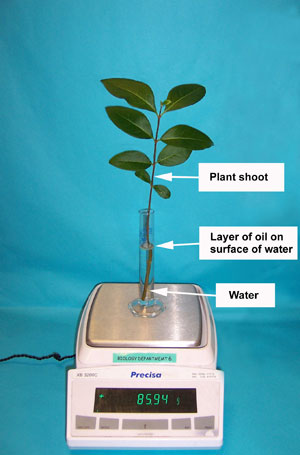Estimating rate of transpiration from a plant cutting
Demonstration
In this activity, cut a shoot from a plant and place it in a measuring cylinder of water. Weigh the whole apparatus, then leave for a period of time during which the plant will lose water by transpiration. Weigh the apparatus again. You can also measure the change in volume directly, but with low accuracy.
Lesson organisation
This activity could be set up as a demonstration as described below, with 2-3 plant cuttings taken by teacher or technician at intervals over a couple of days. Try to take cuttings as early and as late in the day as you can, to get gaps of close to 8 or 16 hours between cuttings. Alternatively, a teaching group could prepare a set of cuttings and make measurements in their next lesson. Students can evaluate this method and propose improvements. This would be a good precursor to a practical involving a more sophisticated potometer.
Apparatus and Chemicals
For each set up
Plant cutting with stem around 8 cm long and leaves at the top – privet is ideal, or you could try busy lizzie (Impatiens) or pot geranium (Pelargonium)
Beaker of tap water
Cooking oil, about 10 cm3
Balance, sensitive to ± 0.1 g
Measuring cylinder (10 cm3 or 25 cm3)
Teat pipette, 2
Scissors
Sellotape
Trays (Note 1)
Health & Safety and Technical notes
Some students may be allergic to or suffer skin irritation in contact with plant sap.
1 Tape the measuring cylinders to trays to reduce the risk of knocking the apparatus over between lessons.
2 Depending on the season and the state of the plants, the stomata may close, limiting transpiration. Placing the cuttings near a high intensity (but cool) light will help to get things going. Fluorescent striplights would be suitable.
3 If you don't have enough measuring cylinders, you could use conical flasks.
Ethical issues
There are no ethical issues associated with this procedure.
Procedure
SAFETY: Take care with sharp blades when cutting the plant stems.
Be aware that some people may be irritated by plant sap.

Preparation
Start preparing cuttings 2 days before the lesson.
a Put water in 3 measuring cylinders.
b Take 3 similar cuttings from the plant using scissors. Try to get a length of stem about 8 cm long with several leaves at the top.
c Place the plant cutting in the measuring cylinder.
d Adjust the water level to an exact level (for example 8 cm3) using the teat pipette.
e Make a note of the volume of water.
f Add about 1 cm3 of oil to the measuring cylinder using the second teat pipette, so that the oil sits on top of the water. Try not to get oil on the leaves.
g Place the apparatus on the balance and record the mass.
h On the measuring cylinder, write the starting volume of water, the mass of the apparatus and the time and date the apparatus was set up.
i Tape the measuring cylinder to a tray (Note 1).
j Take 3 more cuttings at timed intervals for the next couple of days.
Investigation
k In the lesson, the teacher (or technician) could demonstrate how a cutting is treated to set up the apparatus.
l The students can weigh each set of apparatus and accumulate the data as a class set, recording how long ago the cylinders were set up, and how much the mass and volume have changed.
Teaching notes
Uptake of water gives an estimate of water loss by transpiration. However, if the plant tissues were not fully hydrated at the start, or are not fully hydrated now, the estimate could be incorrect in either direction.
Also, plants use some of the mass of water they absorb to make carbohydrates by photosynthesis.
If the plant cuttings are growing actively, some increase in mass could be due to growth, which will mean the transpiration rate is under-estimated. Conversely, if some leaves die, there will be a loss in mass that will over-estimate the rate of transpiration.
Health and safety checked, September 2008
Downloads
Download the student sheet ![]() Estimating rate of transpiration from a plant cutting (95 KB) with questions and answers.
Estimating rate of transpiration from a plant cutting (95 KB) with questions and answers.
Related experiments
Measuring rate of water uptake by a plant shoot using a potometer


